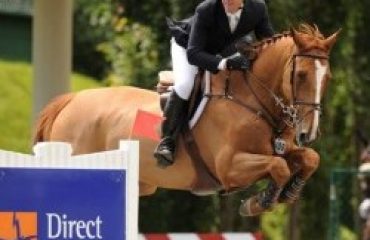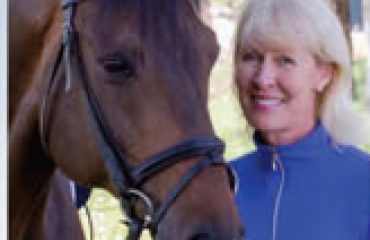
Brian Walker
Photo by Hervé Bonnaud, 1clicphoto.com
Brian Walker, a dual Canadian and American citizen, has trained, worked and ridden alongside the best in the world over the last 25 years. As a junior, Brian won the Maclay Medal Equitation Championship in 2001. Brian has made a name for himself by developing quality horses into successful competitors in both the hunter and jumper arenas, earning accolades for himself and his clients. Do you have a question you want Brian to answer? Send questions to editor@sidelinesnews.com.
I recently tried to do an open water jump with my horse, but he got scared and ever since has refused to go near the open water course. How can I get my horse to gain more confidence and be ready for the open water jump?
Open water can be a tedious jump for both horse and rider. Most of the time, the rider tends to be more afraid of the water than the horse. When a rider doesn’t want to really go to the other side, neither does the horse. On the occasion a horse jumps the water and has an accident, then the horse, justifiably, will have an excuse to not want to go.
First, the rider needs confidence jumping open water, so it’s best to practice on a horse that jumps it with ease, no matter how it’s ridden. A horse that needs confidence jumping open water needs a good ride and practice jumping smaller waters in different environments. I like to make a small water with the same setup as if it were a big water. You can gradually make the water larger, and with time and good training, it should become a non-issue. Keep in mind, a horse that’s shy on the water with a rider that is also shy isn’t typically a good combination when attempting a successful water jump.
My horse and I have been working on our Liverpool jumps without rails over the past few months, and we’ve basically mastered it. However, when we do the same jumps with rails, my horse’s back legs hit the rail and we don’t make it completely over the water. Do you have advice for practicing?
A Liverpool is simply to change the horse’s perspective of a jump. If the horse tends to knock it down, it’s because they spooked at the Liverpool underneath it. Jumping it without rails might be good, just to get the horse accustomed to the Liverpool, but it’s unrealistic because you never have to jump one in the ring without poles over it. If your horse doesn’t jump it well, then more practice is in order. Start with just a small jump, then gradually make it higher. You can use a voice aid to encourage the horse to go forward; if the horse is spooky, you might also need use more leg at this jump. Repetition is the key, and with time, it should be like any normal jump.
At competitions, my horse is well-behaved during the hack. However, when we have to line up in the center of the ring, I can’t get him to stand still, which sometimes has a negative impact on our results. How can I get him to stand still at the end of a class?
Horses can be agitated at the end of the hack. But with some smart horsemanship, you could use this to your advantage to say, “remember me.” Take your time getting to the line to avoid having to stand in line for longer than you really need to. Once they start calling the results, you can let your horse walk a small circle. Figure out where your horse is most comfortable. Maybe it’s best to be on the end closer to the in-gate, or be on the opposite end, or with horses on either side. I like to be on the ends with a horse that doesn’t like to stand. Don’t make a big deal about it and just let them keep moving. If your horse is a good enough mover, it won’t matter.
Whenever I’ve practiced jumping, I’ve always ridden with a horse that isn’t my own. I’d like to buy my own horse to compete with, but I am unsure as to whether to give more consideration to the breed or to the age. What would you suggest?
If you are in the market to buy a horse, let your trainer find the right one for you. Green riders should not be buying green horses; in this case, the older the better. Breed should have no relevance or influence on your purchase decision. A good horse is a good horse and the right match is the right match, no matter what breed or color it is. A horse with experience can teach a new rider more than one would think.












